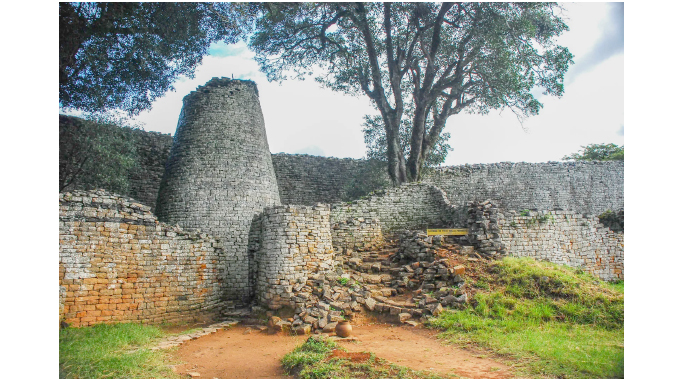
The Sunday News

Yoliswa Dube-Moyo, Features Editor
Mining was a blossoming industry before the whites set foot in the country with “sophisticated” value addition facilities in place to promote trade and development.
According to research, the Zimbabwe mining legacy dates back to Great Zimbabwe where the Munhumutapa Empire had command over and exploited not less than 4 000 gold and 500 copper mines spread across the country.
As part of a value addition process, gold was made into articles of jewellery and used to decorate articles such as knife handles, ceremonial axe handles and other articles of religion.
Archaeological evidence for such domestic use of gold is abundant at Great Zimbabwe and related sites.

Great Zimbabwe
Gold and copper were major items of trade; first along the Limpopo River to Sofala on the sea and later along the Zambezi River to Beira on the Indian Ocean.
But with colonisation, our kinsmen lost control of the country’s inanimate resources as the white settlers exploited the vast mineral reserves across the country.
Cheap labour in the mines became intense following the promulgation of the Mines and Minerals Act to promote the growth of the mining industry.
Mining and agriculture were the leading primary industries, with mining contributing more revenue until 1945 when it was replaced by agriculture.
Back then, blacks were viewed as lesser human beings and white settlers believed in their superiority.
Black men toiled in the mines with no real returns for their labour. They were low level employees and did not hold management roles.
The racist ideology such as the civilising mission and the doctrine that blacks were lesser people was at the core of the justification for colonisation, which the sons and daughters of the soil fought tooth and nail against.
White settlers believed in such theories of superiority which purported that whites were more advanced than blacks, who they believed were of low morality and incapable of controlling themselves.
This racist ideology was the basis for a series of discriminatory legislation such as the Sale of Liquor to Natives and Indians Regulations 1898, which prohibited the sale of alcohol to black people in Southern Rhodesia as well as the Immorality and Indecency Suppression Act 1903, which criminalised sexual acts between white women and black men.
Politically, blacks were excluded at every level and the Public Services Act of 1921 prohibited black people from employment in the civil service. Blacks were also largely disenfranchised through a series of qualifications.
The 1923 Constitution enforced income and property restrictions that were unattainable for the majority of blacks.
The whites also allocated themselves vast tracts of fertile land while blacks were relegated to the dry and arid reserves.
Rhodesia was established under the sponsorship of Cecil John Rhodes and his British South Africa Company and he firmly believed in the White-Man’s Burden idea of the duty of the Anglo-Saxon race to help “civilise” the “darker” corners of the world and regarded British imperialism as a positive force for this purpose.
The settlers that occupied Zimbabwe shared this view of the world and treated the indigenous black people as children that needed guidance, protection and civilisation.
Racial segregation permeated the colonial project at every level, whether it was in sports, hotel facilities, or the use of public conveniences and amenities.
It was not until the country attained its independence from white minority rule in 1980 that blacks started to have access to mining concessions and rising to manage mines and conglomerate mining operations.
For women, venturing into economic spheres, let alone mining, which was largely considered a man’s world, was a distant dream as they were equated to children. One of the country’s major milestones has been the growth of the extractive industry which is well on course to attaining the US$12 billion mining milestone by the end of the year.

Renewed investment interest in the mining sector has seen the establishment and expansion of critical mining operations across the country with the gold sector expected to deliver the 100-tonne target.
President Mnangagwa launched the US$12 billion mining industry strategic roadmap in 2019 and its targets are set to be met this year. The mining sector is critical in generating foreign currency, contributing about 70 percent of the country’s forex earnings, largely driven by gold, platinum, and diamond.
Leading mining companies such as Blanket Mine, Pretoria Portland Cement (PPC) and Duration Gold are already seized with the implementation of different expansion projects that involve millions of United States dollars.
These are being complemented by artisanal small-scale mining breakthroughs in different resource districts, which have seen the sub-sector contributing more to formal gold deliveries.
Blanket Mine, which is owned by Caledonia Corporation, has already completed a new central shaft project under a US$70 million expansion project and is now focused on establishing a solar plant to enhance its energy supply.
The investment is already impacting positively on improved quarterly output with the company now officially trading on the Victoria Falls Stock Exchange (VFEX).

Victoria Falls Stock Exchange
PPC, which operates a clinker production plant in Colleen Bawn has also maintained steady operations and recently unveiled a US$40 million solar power investment for its Bulawayo and Colleen Bawn plants, which will boost the firm’s energy requirements and help reduce the supply gap in the country.
The planned projects are expected to yield a combined output of 30MW, of which 17MW is for internal consumption with the excess of 13MW set to be fed into the national grid.
The country’s independence made it possible to have a level playing field where businesses can expand their operations and make meaningful contributions towards the country’s Gross Domestic Product.
In his autobiography, The Story of My Life, the late Vice-President Dr Joshua Mqabuko Nkomo says when he became a man, he understood that he could not be free while his country and its people suffered.
Before the country attained its independence in 1980, Zimbabweans were subjected to a government in which they had no say.
Politically, Dr Nkomo said, Smith tried to set up an internal deal which would preserve the power of the white minority but give his friends in the outside world some justification for claiming that Rhodesia was now multiracial and could therefore be recognised.
“I agreed to talk to Smith, face-to-face. In absolute secrecy we met at State House, Lusaka as the guests of Kenneth Kaunda. I found Smith a tired man, a battered man. He told me he wanted to surrender power, to hand the whole thing over; I am convinced that he knew the game was up. That the time had come to concede defeat. But I could not on my own accept his offer,” said Dr Nkomo.
He says our war of independence was longer and cruel.
“They (whites) must have known in their hearts that they couldn’t in the long run perpetuate their rule. We had no alternative to taking up arms. By their prolonged resistance, the settlers themselves fostered bitterness not only between themselves and the black majority but also between the various African factions struggling for justice in prison or in exile.”
Hardly a family in our country was unaffected by the bloody war that was forced upon us, said Dr Nkomo.
“Tens of thousands of young people grew up knowing nothing but chaos and disruption — living in danger, in the bush, in exile, in makeshift camps, outside the steadying framework of established communities. The war was necessary and I do not regret my part in it. The price of freedom can never be too high,” said Father Zimbabwe.
The signing of the Lancaster House Agreement on 21 December 1979 brought an end to the illegal white-dominated regime that had ruled Rhodesia since the Unilateral Declaration of Independence (UDI) in 1965, and ushered in the newly independent state of Zimbabwe.
Had it not been for the bloodied war and sacrifices by our countrymen, Zimbabwe’s wealth would have remained in the hands of the white minority.
The projects have been expansive since the country attained its independence with Duration Gold subsidiary, Vubachikwe Mine, recently having launched its US$2,6 million Tailings Storage Facility (TSF), which is expected to extend the mine’s depositional life by a further 20 years.
Duration Gold Limited recently embarked on an airborne geophysical survey through partnership with world leader Xcalibur Airborne Geophysical Surveys from South Africa, a move expected to culminate in the country having a better appreciation of its mineral potential.
With a modern approach to airborne geophysical surveying, the radiometric and magnetic survey is the second largest such endeavour of its kind, following another such project conducted in the 1980s.
The establishment of a US$1 billion iron ore mining and value-addition industrial park in Manhize, Chirumanzu District, Midlands Province is also expected to positively impact the country’s extractive sector and assist Zimbabwe to wean itself from reliance on imports.



